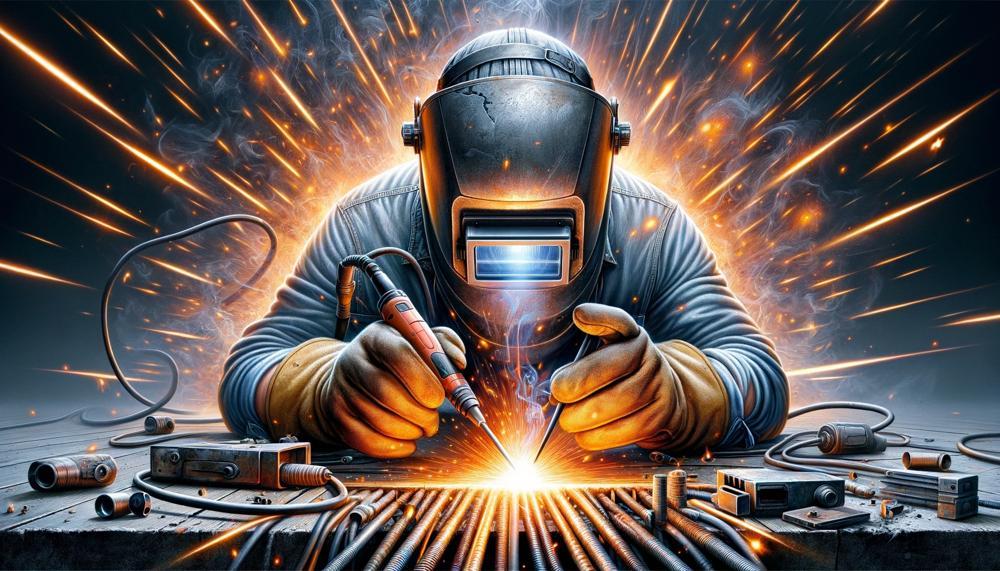Our contemporary industrial sectors and infrastructure are based on the old and vital skill of welding. There are risks associated with this painstaking process of carefully fusing materials together, particularly for the people wearing the masks.
The danger to one’s vision is one of the most serious and avoidable of these. We’ll go deep into the realm of welding in this post, shedding light on how this important activity might affect eye health.
We’ll make our way through flames and sparks to learn the real hazards and protective precautions for the artists who, one weld at a time, link the globe.
So, does welding hurt your eyes?
Yes, welding can hurt your eyes. The welding process emits optical radiation, including infrared, visible, and ultraviolet (UV) light, which can cause eye injuries. For example, welding torches are a common source of UV light that can cause flash burns, also known as “welder’s flash” or “arc eye”. Flash burns are similar to sunburns in the eye and can cause painful inflammation of the cornea. Other symptoms of flash burns include:
- Tearing
- Reddening of the eye and membranes around the eye
- Pain
Symptoms of flash burns, such as pain, swelling, and blurred vision, usually appear 6 to 12 hours after the burn.
Let’s get started now.
Contents
- 1 Does Welding Hurt Your Eyes?
- 2 Why does welding hurt your eyes?
- 3 Can welding result in eye floaters?
- 4 Your Eyes Can Be Damaged By Radiation As Well As Other Factors
- 5 Welding-Related Eye Injuries
- 6 How To Treat Your Eyes If They Are Hurt With Welding
- 7 Welding Eye Safety: How To Prevent Eye injuries
- 8 Recommended Articles
- 9 Conclusion
Does Welding Hurt Your Eyes?
Yes, welding can indeed hurt your eyes if you don’t take the right precautions. The risks are real and varied, ranging from immediate discomfort to long-term damage. But fear not, for every risk, there’s a countermeasure waiting in the wings to keep those peepers safe and sound.
Potential Risks to Your Eyes While Welding
| Risk | Description | Long-term Effects |
| UV Radiation (Arc Eye) | Exposure to intense UV light causes inflammation akin to a severe sunburn but on the eye’s surface. | Can lead to cataracts and other vision impairments over time. |
| Infrared Radiation | Causes thermal burns by overwhelming the eye with too much heat. | Potential for irreversible damage to the retina, leading to vision loss. |
| Flying Debris | Metal fragments or sparks can strike the eye, causing cuts or embedding foreign objects. | Risks include infections, corneal abrasions, and even loss of the eye. |
| Intense Light and Heat | The bright light and heat can cause strain and fatigue to the eyes. | Continuous exposure increases risk of chronic eye conditions and fatigue. |
Why does welding hurt your eyes?
Welding radiates a storm of hazards – from UV to infrared rays, each stealthily harmful. The human eye, sensitive and unprotected, can be easily scorched by these invisible threats. The bright light, a welding arc’s glare, assaults the retina, leading to temporary or lasting vision damage.
Photokeratitis, akin to sunburn of the cornea, manifests in a gritty feeling, watering eyes, and discomfort in bright light. Retinal damage, a more grievous consequence, can mar vision permanently, leading to macular degeneration or cataracts.
Even the seemingly innocuous task of observing can be a sly threat. Debris, as tiny as a whisper, can lodge in the eye, risking rust and lasting harm.
Safety, thus, is not a mere accessory but a necessity. The welding helmet, armed with ANSI-standard lenses, stands as the guardian against these invisible foes. Choosing the right lens shade is pivotal, matching it to the task at hand to ensure the eyes are shielded from the welding storm.
Can welding result in eye floaters?
Absolutely. The intense light and radiation from welding can lead to a variety of eye issues, including the development of eye floaters. Here’s how it ties together:
- UV and Infrared Radiation: Welding emits strong ultraviolet (UV) and infrared radiation, which can burn the retina and the cornea, leading to inflammation and damage. This damage can lead to the formation of floaters as the eye heals.
- Intense Light and Heat: The bright light and heat from welding can cause the vitreous humor in the eye to shrink or change shape, leading to the creation of floaters.
- Flying Debris: Small particles can enter the eye, causing scratches or more serious damage. As the eye heals, floaters can form.
Your Eyes Can Be Damaged By Radiation As Well As Other Factors
Welding, a craft revered and rigorous, demands not only skill but also a steadfast vigilance towards safety, especially concerning one’s eyes.
The brilliance of a welding arc, akin to a miniature sun, harbours not just light but a spectrum of radiation, invisible yet formidable, that can besiege the eyes with various ailments.
| Risk | Consequence | Preventive Measure |
| UV Radiation | Photokeratitis (Welder’s Flash), Long-term eye conditions | Welding helmet with correct shade lens |
| Infrared Radiation | Heat damage to the eye | Welding helmet with proper filtering |
| Visible Light Radiation | Temporary blindness, Distraction | Auto-darkening welding helmet |
| Flying Debris | Scratches, Embedded objects, Infection | Safety glasses beneath welding helmet |
Welding-Related Eye Injuries
Welding-related eye injuries can indeed pose a significant risk to those in the trade, exposing them to dangers that, if not properly mitigated, could lead to lasting harm.
The craft of welding, crucial in industries from construction to automotive repair, melds metals with intense heat. Yet, this process, while creating unyielding bonds, also emits hazards to the unwary.
Most Common Eye Injuries
- Burns: The searing heat of welding can cause burns around the eyes, leading to discomfort, redness, and blistering. In dire cases, it scars.
- Corneal Flash Burns: The invisible threat of ultraviolet (UV) radiation during welding can burn the eye’s surface, sparking pain, light sensitivity, and blurred vision.
- Arc Eye (Welder’s Flash): A sinister foe, arc eye results from UV radiation exposure, risking permanent corneal damage and symptoms like intense pain and halos around lights.
How to Sidestep These Hazards
The cornerstone of prevention lies in personal protective equipment (PPE), ventilation, and education.
How To Treat Your Eyes If They Are Hurt With Welding
In the craft of welding, safeguarding one’s vision cannot be overstated. Yet, should the unfortunate occur and one’s eyes suffer injury from welding, there are practical steps to mitigate the harm. Here’s how:
| Immediate First Aid | Professional Medical Treatment | Post-Treatment Care |
| Flush eyes with water for a minimum of 15 minutes to expel any foreign particles or chemicals. | Seek urgent medical attention for a thorough eye examination and appropriate treatment. | Rest your eyes and avoid bright lights or screen time to aid recovery. |
| Apply a cool, damp cloth to alleviate pain and swelling for burns from UV or IR radiation. | For burns or retinal damage, treatments may include prescribed eye drops or ointments to promote healing and prevent infection. | Use prescribed medication exactly as directed and attend all follow-up appointments. |
| Do not rub or press your eyes, as this can exacerbate the injury. | In cases of severe damage, such as retinal damage, specialized treatments like laser therapy or surgery may be necessary. | Maintain a protective environment for your eyes, avoiding dust and debris. |
Welding Eye Safety: How To Prevent Eye injuries
To keep one’s peepers safe whilst engaged in the craft of welding, a blend of gear, vigilance, and proper practice is essential. Below, we delve into measures that can drastically reduce the risk of eye mishaps in the welding trade.
Select the Right Eye Protection
Not all shields are crafted equal when it comes to welding. Choose a helmet or goggles that not only fit snugly but also boast a shade level tailor-made for the welding technique at hand.
| Equipment Type | Usage | Shade Level |
| Welding Helmet | General Welding | Varies by process |
| Welding Goggles | Precision Tasks | Appropriate for task |
| Safety Glasses | Secondary Protection | Not applicable |
Maintain a Respectful Distance
Keep yourself a safe berth from the weld zone. This diminishes the peril of harmful rays and rogue sparks making contact with the eyes.
Regular Gear Inspection
Frequently examine your protective wear and welding kit. Any wear or malfunction can be a gateway to injury.
Employ Screens and Barriers
When the situation warrants, setting up screens or barriers can safeguard others in the vicinity from the stray sparks or intense light that can lead to eye damage.

Be Aware of the Environs
Awareness is key. Recognise potential hazards like flying debris or chemical exposures and strategise accordingly to mitigate risks.
Prompt Response to Injuries
Despite all precautions, accidents can occur. Should an eye injury transpire, seeking immediate medical attention is paramount to prevent further damage.
Adhering to these guidelines not only shields your eyes but also ensures the longevity of your welding career.
Recommended Articles
Certainly, welding is not just a craft but an art that demands respect for safety, especially concerning one’s vision. The blaze of the torch brings risks as much as it does rewards, making eye safety paramount.
To guide and protect, here are key articles, rich with insights and advice on mitigating the hazards that welding poses to the eyes:
| Title | Source | Key Highlights |
| Eye Protection in Welding Operations | Occupational Safety and Health Administration (OSHA) | Explores various eye injuries in welding, recommending protective gear and highlighting the significance of understanding specific risks associated with different welding processes. |
| Eye Injuries in Welding and Cutting | American Welding Society | Delivers an in-depth analysis on the spectrum of eye injuries from welding, underlining the essence of safety training and proactive measures to safeguard vision. |
| Eye Hazards in Welding | Centers for Disease Control and Prevention (CDC) | Outlines common ocular hazards in welding, advising on the selection of appropriate eye protection such as helmets, goggles, and face shields to fend off UV and IR radiation. |
| Preventing Arc Eye in Welding Operations | The Fabricator | Spotlights the peril of arc eye, offering preventative strategies and the importance of routine eye examinations for welders to detect and address potential eye damage early. |
| The Hidden Dangers of Welding | Safety+Health Magazine | Discusses varied welding hazards, including those to eyesight, emphasizing the role of employers in furnishing training and personal protective equipment to avert injuries. |
Conclusion
In conclusion, it is important to remember that welding, a noble and necessary skill, has serious hazards to the eyes.
Respect and care are necessary due to the bright light, radiation, and physical risks associated with welding in order to avoid both short-term and long-term eye injury. The potential for danger is as wide as it is severe, ranging from the searing glare of UV rays that cause conditions like “welder’s flash” to the sneaky menace of flying debris.
But the story doesn’t conclude on a dangerous note. The safety precautions that, when properly put in place, may safeguard the welder’s eyes from these potential hazards are just as strong.
As this conversation has shown, knowledge becomes the lighthouse that directs welders across the turbulent seas of possible dangers and into the safe haven of long-term eye health and skill.





